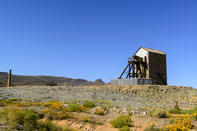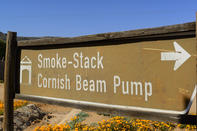Cornish Beam Pump
Copper was discovered in Okiep as early as 1855 and during the accompanying mining rush miners from all over the world found their way here. Within a year Okiep was the home of the world’s largest copper mine and nowadays visitors can take a tour of the mine to view the mine shafts and smelting towers.
The remains of the Anglo-Boer War, Crow’s Nest Blockhouse, can be seen on a hill north east of Okiep. It fell to the Boers and was occupied by them for most of the siege before being retaken. Fort Shelton saw the major part of the action during the siege and was manned by a six-pounder gun.
Graffiti made by the Cape Town Highlanders and Cape Garrison Artillery can be seen in the Okiep East Mine, while casualties from the war were laid to rest in the Okiep graveyard. The old smelter smoke stack and Cornish Beam Pump are both extant and will interest those with a mineralogical bent. There are also the remnants of old ore bins, mine houses, granaries and stone-built churches built by the many Cornish tin miners and masons who came to Namaqualand during the copper boom.
The Cornish Pump House is a fully intact steam engine which is the only remaining pump house of its sort in the Southern Hemisphere and was used from 1882 to pump water from the mine.

